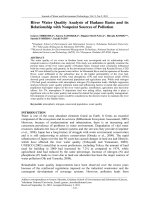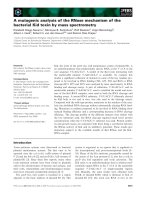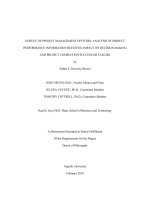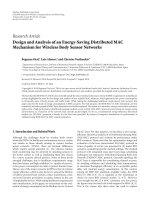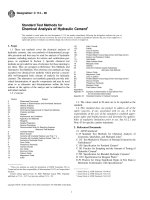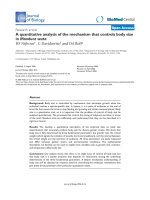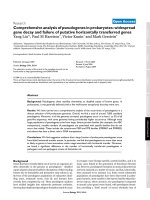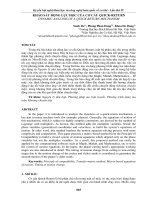Analysis of hydraulic failure mechanism of river b
Bạn đang xem bản rút gọn của tài liệu. Xem và tải ngay bản đầy đủ của tài liệu tại đây (624.88 KB, 6 trang )
IOP Conference Series: Earth and Environmental Science
PAPER • OPEN ACCESS
Analysis of Hydraulic Failure Mechanism of River Bank Protection and
Reinforcement Treatment Practice
To cite this article: Shijiao Luo 2020 IOP Conf. Ser.: Earth Environ. Sci. 508 012108
View the article online for updates and enhancements.
This content was downloaded from IP address 158.46.167.3 on 01/07/2020 at 18:12
ICEMEE
2020
Conf. Series: Earth and Environmental Science 508 (2020) 012108
IOP
IOP Publishing
doi:10.1088/1755-1315/508/1/012108
Analysis of Hydraulic Failure Mechanism of River Bank
Protection and Reinforcement Treatment Practice
Shijiao Luo
Country School of Soil and Water Conservation, Beijing Forestry University, Beijing
100083, China
*
Corresponding author’s e-mail:
Abstract. Based on the reinforcement engineering of the revetment retaining walls at the lower
reaches of a reservoir, this study analyzes the fracturing mechanism and proposed technicallyadvanced, economical and feasible reinforcement measures, which provide important reference
for similar engineering work.
1. Introduction
River bank revetments are structures that reinforce and protect river banks from hydraulic fracturing.
Concrete revetments are the most common revetment structure currently. Natural river banks are
susceptible to scouring of floods, so the bank revetments usually are damaged or even collapse,
endangering those protected by the revetments. Therefore, it is of practical value to understand the
fracturing mechanism of revetments and propose advanced, economical and feasible revetment
reinforcement measures. Based on the reinforcement schemes of the revetment at the lower reaches of
a reservoir, this study analyses the hydraulic fracturing mechanism of the revetment and proposed
reinforcement measures.
The reservoir studied herein has undergone a flood that lasted 22 hours in September 2018. When
the reservoir was discharging the flood, the flood destructed the galvanized gabions on the surface of
the lower-reach river bed of the flood discharging architecture, the bottom part of the bank revetment
was emptied due to flood scouring, part of the retaining wall were deformed and sloped towards the
water-facing side, the expansion joint between the blocks of the retaining wall extended or compressed,
the concrete on the top surface of the retaining wall was scaled off.
When the flood occurred, reinforcement measures were taken. Galvanized gabions were filled to
the foundation of the retaining wall that had been damaged from the emptied bottom part to the river
bed; for the base pits on the back side of the retaining wall where the sludge and loose media were
scoured away, self-compacting concrete was used to fill the base pits (figure 1).
Content from this work may be used under the terms of the Creative Commons Attribution 3.0 licence. Any further distribution
of this work must maintain attribution to the author(s) and the title of the work, journal citation and DOI.
Published under licence by IOP Publishing Ltd
1
ICEMEE
2020
Conf. Series: Earth and Environmental Science 508 (2020) 012108
IOP
IOP Publishing
doi:10.1088/1755-1315/508/1/012108
Figure 1. Scouring conditions of the foundation of the retaining wall.
2. Fracturing mechanism analysis
Natural river banks, under hydraulic actions, are susceptible to scour-and-fill effects. When the force
of scouring is larger than the resistance of rocks, the river bed will be scoured and corroded. The
following two equations are used to calculate the scouring depth.
A. The scouring depths of different media on the river bed rocks can be obtained using Equation
(1). Calculation of river bed scouring depth is shown in table1.
(1)
is the scouring depth of the head end of the revetment bottom on the upper reaches,
Where
(m3/s);
represents the unit discharge of the river bed head end of the revetment bottom on the upper
3
reach (m /s);
represents the allowable non-scouring velocity of the soil along the river bed (m/s);
and
indicates the lower-reach river depth (m).
Table 1. Calculation of river bed scouring depth
Allowable
Single
Downstream
Drainage
Rock-soil
unwashed flow
width flow
water depth
flow
media in river
3
3
(m
/s)
(m/s)
velocity
bed
(m)
(m /s)
Gravel
350
9
1.0
2.54
Conglomerate
350
9
2.5
2.54
Scouring
depth
(M)
4.8
0.3
B. The scouring depth on the surface of the riverbed can be obtained by using Equation (2).
Calculation of river bed scouring depth is shown in table2.
(2)
where
is the unit discharge at the end of the protection apron (m3/s);
the end of the protection apron (m);
is the depth of water at
is the altitude of highest flowing velocity in the flowing
velocity distribution chart at the end of the apron (m);
refers to the correction factor of the
momentum of flow velocity distribution at the end of the apron;
2
is the water depth of the lower
ICEMEE
2020
Conf. Series: Earth and Environmental Science 508 (2020) 012108
IOP
IOP Publishing
doi:10.1088/1755-1315/508/1/012108
reach (m); is the grain diameter of the river bed sand ( ) (m); and and is the unit weight of
the river water and bed materials (KN/m3).
Table 2. Calculation of river bed scouring depth
Water depth
Erosion
Drainage Single width
Bed sand
Riverbed
Sand particle
at the end of
depth
flow
flow
volume
geotechnical
size
(mm)
the apron
3
3
3
(m)
media
(m /s)
(m /s)
(KN/ m )
(m)
Gravel
350
9
2.54
0.015
18
7
Given all calculation results, the maximum of the scouring depth 7.0 m of the river bed is obtained.
Based on the feedback on the on-site drilling materials after damages, the foundation of the retaining
wall was made of sand gravels, and no rocks are used. The sand gravels on the foundation of the
retaining wall is 5.2m-thick, which do not meet the requirements to resist scouring. As a result, the
river bed was corroded, the foundation gravels were emptied and the wall deformed and toppled.
3. Reinforcement measures
3.1. Reinforcement principles
To demolish and reconstruct the retaining wall completely will incur substantial engineering
workloads and high investments. It is advisable to demolish part of the retaining wall considering the
scouring conditions, the storage conditions by emergency reinforcement schemes and the damaging
degrees.
3.2. Reinforcement measures
The damaged retaining wall is 90 m long, so permanent reinforcement should be performed on 110 m
of the wall on the water-facing side. Slope-protection concrete should be used to reinforce the front
part of the wall and to avoid scouring by water. Structure of permanent revetment reinforcement is
shown in figure 2 and the detailed measures are as follows.
1) Digging up the surface sand gravels of the river bed at the front of the retaining wall foundation,
and the digging depth should reach the surface of the conglomerate layer. The digging depth should be
3 -5 m, and the width should be 3 m.
2) Sorting the galvanized gabions that were thrown into the revetment pits during rescue and
improve the side slope. The gabion is 3 m wide on the top, and the side slope should be 1:1.5.
3) A dredge should be dug at the bottom of rocks that protrude above the surface, and the size is
1×1 m. when the dredge is created, steel gabions of a size of 0.75×0.75×1.5 m are put into the dredge.
4) Φ25 joint bars should be installed onto the slope of the bulk rockfill, the length is 1 m, the
spacing is 1 m, and the bar is 0.1 m above the surface. Self-compacting concrete should be injected
into the bulk rockfill slope and the steel gabions. The injection spacing is 1 m, and the depth should be
above 1.0 m.
5) Ф8 steel grids are installed on the slope, with a 200×200 mm spacing. The grids are wielded
with theφ25 joint bars. 0.2m-thick slope-protection concrete is injected to create a toe protection
structure that integrates the concrete protection backplate and steel gabions.
6) After the concrete protection plate is injected and maintained for 14 days, large rocks of a
diameter bigger than 300 mm are filled for 2 m above the bottom, and the top is covered by the
materials that have been dug up.
3
ICEMEE
2020
Conf. Series: Earth and Environmental Science 508 (2020) 012108
IOP
IOP Publishing
doi:10.1088/1755-1315/508/1/012108
Figure 2. Structure of permanent revetment reinforcement.
4. Conclusions
The reinforcement measures described above should be conducted under the premise that the original
retaining wall is not demolished. These measures include setting toe protection structures below the
scouring depth of the retaining wall to stabilize the original structure. The practice proves that the
measures are reasonable and feasible.
4
ICEMEE
2020
Conf. Series: Earth and Environmental Science 508 (2020) 012108
IOP
IOP Publishing
doi:10.1088/1755-1315/508/1/012108
References
[1] Rinaldi M, Darby S E. 9 Modelling river-bank-erosion processes and mass failure
mechanisms: progress towards fully coupled simulations[J]. Developments in Earth
Surface Processes, 2007, 11: 213-239.
[2] XU X, WANG J, HUANG R. Research on deformation and failure mechanism of the talus
slope located at the left riverbank ahead of the dam of Zipingpu hydraulic project[J].
Chinese Journal of Rock Mechanics and Engineering, 2008, 27(Sup 1): 2.
[3] Osman A M, Thorne C R. Riverbank stability analysis. I: Theory[J]. Journal of Hydraulic
Engineering, 1988, 114(2): 134-150.
[4] Dapporto S, Rinaldi M, Casagli N, et al. Mechanisms of riverbank failure along the Arno
River, Central Italy[J]. Earth Surface Processes and Landforms: The Journal of the
British Geomorphological Research Group, 2003, 28(12): 1303-1323.
[5] Hossain M B, Sakai T, Hossain M Z. River embankment and bank failure: a study on
geotechnical characteristics and stability analysis[J]. American Journal of
Environmental Sciences, 2011, 7(2): 102.
[6] Wenchou Y U. River boundary conditions of mechanism of bank failure in middle and
lower reaches of Changjiang River[J]. Journal of Yangtze River Scientific Research
Institute, 2008, 25(1): 8-11.
[7] Thorne C R. Processes and mechanisms of river bank erosion[J]. Gravel-bed rivers, 1982:
227-271.
[8] Zhang X N, Jiang C F, Ying Q, et al. Review of research on bank collapse in natural
rivers[J]. Advances in Science and Technology of Water Resources, 2008, 28(3): 80-83.
5
